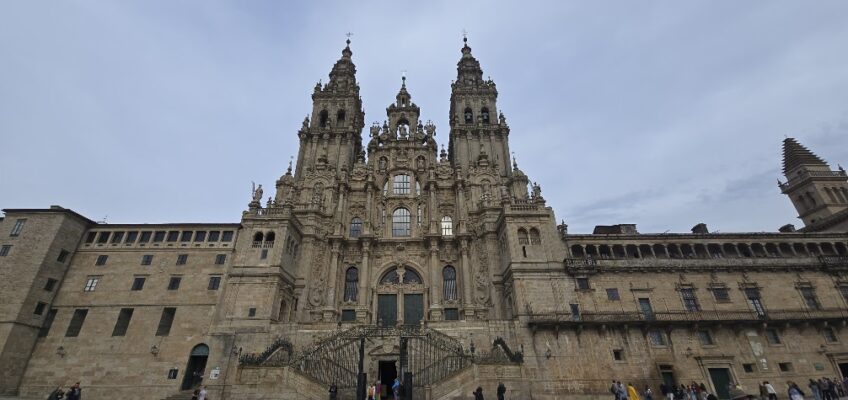It wasn’t a genuine pilgrimage, since the vast majority of it was by bus. But starting in France, I made my way (with my tour group) across northern Spain, and we arrived in Santiago de Compostela feeling more or less like pilgrims. We spent three nights there and got to see some other parts of Galicia, such a beautiful corner of Spain.
You can find my photos of Galicia here.
Arriving at Kilometer Zero
I don’t know what it must feel like to arrive if you’ve been walking for days, weeks, or months. And I can’t even begin to imagine what it must have felt like hundreds of years ago, before there were apps, Airbnbs, and vans to carry your gear to each night’s lodging.
I also don’t know what it must feel like for believers. The original pilgrims wanted to see the tomb of Saint James for themselves. They sought forgiveness or absolution for their sins. More recently, the journey has taken on spiritual meaning. The route is not as difficult as it once was, but I’m sure it is no less meaningful to those who walk it.
We arrived in Santiago on Thursday afternoon, and Mafalda, our trip leader, took us for a walk to see the facade of the cathedral. Then on Friday morning we took the bus to the outskirts of the city and walked the last mile of the Camino. Arriving at Kilometer Zero after that felt really meaningful. I felt connected to the millions of people who have done it over the centuries. And it made me feel like I’d want to do it for real.
I wonder what I could learn, about myself and about the world, on the Camino.
Santiago de Compostela
This is a very attractive city!
Santiago Cathedral
The Cathedral is certainly its centerpiece, and it is a sight to behold from the outside. (See the photo at the top of the page; there are more photos of the exterior in the photo album.) But the inside was strange. The nave is stolid Romanesque, offering nothing to feast the eyes on. Apparently it originally had some 80 glorious alabaster windows, but these were all bricked up when other buildings sprang up around the church.
The 11th-century church, however, has a 17th-century altar. And whoever designed it didn’t seem to care that it in no way fit the character of the church. It is Baroque, but also baroque in the worst sense of the word.
There’s also that big silver thing hanging from the ceiling. That’s the botafumiero. During some special masses, it swings across the transept of the cathedral. Apparently, this is quite a spectacle. You can request it for 500 euros. After communion, eight men pull on the rope and the contraption swings in a wide arc back and forth, spewing incense. I didn’t get to see this, but here’s a video:
If you go down a short staircase, you can visit the tomb of Saint James:
And then you can climb into the altar to hug him from behind. (I just gave him a pat on the back.)
There are two other Jameses in the altar:

The Portico of Glory
The beautiful Baroque facade of the Cathedral dates from the middle of the 18th century. This is not what early pilgrims would have encountered when they arrived in Santiago de Compostela. But over the centuries the original facade was deteriorating, so the local bishop, just back from Rome and inspired by its Baroque architecture, decided to spruce up the local cathedral with a new exterior.
For a small price (10 euros), I got to go see what is known as the Portico of Glory, i.e. the original main entry to the cathedral. It was recently restored, and it is pretty spectacular.
Those early illiterate pilgrims could certainly have read the message presented here. Old Testament prophets (on the left) announce the coming of the Messiah. New Testament saints, on the right, proclaim his message. Jesus Christ sits on his throne at the top, surrounded by Matthew, Mark, Luke, and John. Beneath him is our friend Saint James, resting his feet on a column with the Tree of Jesse showing the genealogy of Jesus, from Jesse, up to David, and then up to Mary; above her is the trinity: father, son, and holy spirit (represented by a dove). Overhead are 24 musicians playing instruments, and below them are angels presenting a cross, a crown of thorns, nails, a spear, and a jug of vinegar: the signs of Christ’s Passion. (More up-close photos are in the album.)
Other things in Santiago de Compostela
For me the best part of this city was wandering through its old town. There are a lot of churches and plenty of impressive edifices.
Other places in Galicia
As impressive as Santiago de Compostela was, I think I enjoyed some of the smaller villages we visited even more. There were no (or few) monumental structures; just delightful streets to wander.
I sometimes think I spend too much time traveling in cities with big history, big monuments, and big crowds. I want to see those things. I want to see great works of art and architecture.
But coming to small villages like these is mental floss.
My photo album has plenty more photos of Santiago de Compostela and all these other places, as well as some of the stunning scenery we drove past. I hope you will enjoy looking at all my photos.






Leave a Reply